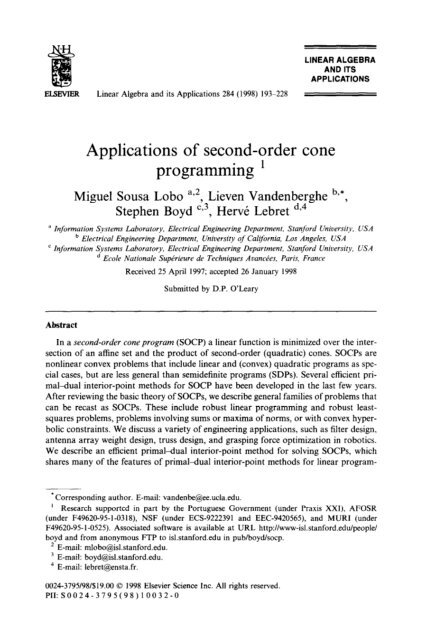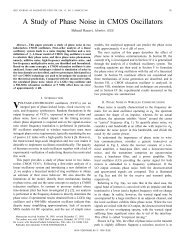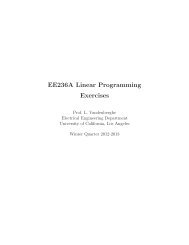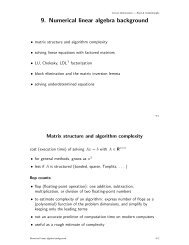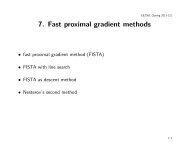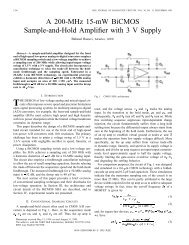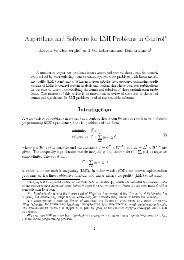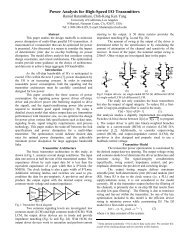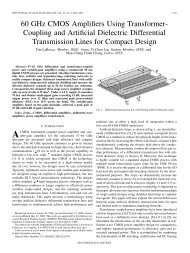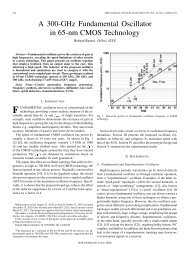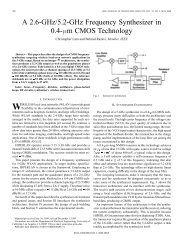Applications of second-Order cone programming ' - UCLA Electrical ...
Applications of second-Order cone programming ' - UCLA Electrical ...
Applications of second-Order cone programming ' - UCLA Electrical ...
Create successful ePaper yourself
Turn your PDF publications into a flip-book with our unique Google optimized e-Paper software.
EISBVIF?R Linear Algebra and its <strong>Applications</strong> 284 (1998) 1933228<br />
<strong>Applications</strong> <strong>of</strong> <strong>second</strong>-<strong>Order</strong> <strong>cone</strong><br />
<strong>programming</strong> ’<br />
LINEAR ALGEBRA<br />
AND ITS<br />
APPLICATIONS<br />
Miguel Soma Lobo a32, Lieven Vandenberghe b,*,<br />
Stephen Boyd c73, Herve Lebret dT4<br />
a Information Systems Laboratory. <strong>Electrical</strong> Engineering Department, Stanford University, USA<br />
b <strong>Electrical</strong> Engineering Department, University <strong>of</strong> California. Los Angeles. USA<br />
’ Information Systems Laboratory, <strong>Electrical</strong> Engineering Department, Stanford University. USA<br />
’ Ecole Nationale Supkrieure de Techniques Avankes, Paris, France<br />
Abstract<br />
Received 25 April 1997; accepted 26 January 1998<br />
Submitted by D.P. O’Leary<br />
In a <strong>second</strong>-<strong>Order</strong> <strong>cone</strong> program (SOCP) a linear function is minimized over the inter-<br />
section <strong>of</strong> an affine set and the product <strong>of</strong> <strong>second</strong>-<strong>Order</strong> (quadratic) <strong>cone</strong>s. SOCPs are<br />
nonlinear convex Problems that include linear and (convex) quadratic programs as spe-<br />
cial cases, but are less general than semidefinite programs (SDPs). Several efficient pri-<br />
maldual interior-Point methods for SOCP have been developed in the last few years.<br />
After reviewing the basic theory <strong>of</strong> SOCPs, we describe general families <strong>of</strong> Problems that<br />
tan be recast as SOCPs. These include robust linear <strong>programming</strong> and robust least-<br />
squares Problems, Problems involving sums or maxima <strong>of</strong> norms, or with convex hyper-<br />
bolic constraints. We discuss a variety <strong>of</strong> engineering applications, such as filter design,<br />
antenna array weight design, truss design, and grasping forte optimization in robotics.<br />
We describe an efficient primaldual interior-Point method for solving SOCPs, which<br />
shares many <strong>of</strong> the features <strong>of</strong> primaldual interior-Point methods for linear program-<br />
* Corresponding author. E-mail: vandenbe@ee.ucIa.edu.<br />
’ Research supported in part by the Portuguese Govemment (under Praxis XXI), AFOSR<br />
(under F49620-95-I-0318), NSF (under ECS-9222391 and EEC-9420565), and MURI (under<br />
F49620-95-1-0525). Associated S<strong>of</strong>tware is available at URL http://www-isl.stanford.edu/people/<br />
boyd and from anonymous FTP to isl.stanford.edu in pub/boyd/socp.<br />
’ E-mail: mlobo@isl.stanford.edu.<br />
3 E-mail: boyd@isl.stanford.edu.<br />
4 E-mail: lebret@ensta.fr.<br />
0024-3795/98/$19.00 0 1998 Elsevier Science Inc. All rights reserved.<br />
PlI:SOO24-3795(98)10032-0
194 M.S. Lobo et al. / Linear Algebra and its <strong>Applications</strong> 284 (1998) 193-228<br />
ming (LP): Worst-case theoretical analysis Shows that the number <strong>of</strong> iterations required<br />
to solve a Problem grows at most as the Square root <strong>of</strong> the Problem size, while numerical<br />
experiments indicate that the typical number <strong>of</strong> iterations ranges between 5 and 50, al-<br />
most independent <strong>of</strong> the Problem size. 0 1998 Elsevier Science Inc. All rights reserved.<br />
Keywords: Convex optimization; Quadratic <strong>programming</strong>; Semidefinite <strong>programming</strong>; Interior-<br />
Point methods<br />
1. Introduction<br />
1.1. Second-<strong>Order</strong> <strong>cone</strong> <strong>programming</strong><br />
We consider the <strong>second</strong>-<strong>Order</strong> <strong>cone</strong> program (SOCP)<br />
minimize f Tx<br />
subjectto IIAi~+b;ll
M.S. Lobo et al. I Linear Algebra and its <strong>Applications</strong> 284 (1998) 193-228<br />
minimize f T~<br />
subjectto O 0) to the (convex) quadratic constraint ]]Aix + bi]]* < df. Thus, when all<br />
ci vanish, the SOCP reduces to a quadratically constrained linear program<br />
(QCLP). We will soon see that (convex) quadratic programs (QPs), quadratic-<br />
ally constrained quadratic programs (QCQPs), and many other nonlinear con-<br />
vex optimization Problems tan be reformulated as SOCPs as well.<br />
1.2. Outline <strong>of</strong> the Paper<br />
The main goal <strong>of</strong> the Paper is to present an overview <strong>of</strong> examples and appli-<br />
cations <strong>of</strong> <strong>second</strong>-<strong>Order</strong> <strong>cone</strong> <strong>programming</strong>. We Start in Section 2 by describing<br />
several general convex optimization Problems that tan be cast as SOCPs. These<br />
Problems include QP, QCQP, Problems involving sums and maxima <strong>of</strong> norms,<br />
and hyperbolic constraints. We also describe two applications <strong>of</strong> SOCP to ro-<br />
bust convex <strong>programming</strong>: robust LP and robust least squares. In Section 3 we<br />
describe a variety <strong>of</strong> engineering applications, including examples in filier de-<br />
sign, antenna array design, truss design, and grasping forte optimization. We<br />
also describe an application in Portfolio optimization.<br />
In Section 4 we introduce the dual Problem, and describe a primal-dual po-<br />
tential reduction method which is simple, robust, and efficient. The method we<br />
describe is certainly not the only possible choice: most <strong>of</strong> the interior-Point<br />
methods that have been developed for linear (or semidefinite) <strong>programming</strong><br />
tan be generalized (or specialized) to handle SOCPs as well. The concepts un-<br />
derlying other primal-dual interior-Point methods for SOCP, however, are<br />
very similar to the ideas behind the method presented here. An implementation<br />
<strong>of</strong> the algorithm (in C, with calls to LAPACK) is available via WWW or FTP<br />
[311*<br />
1.3. Previous work<br />
The main reference on interior-Point methods for SOCP is the book by<br />
Nesterov and Nemirovsky [32]. The method we describe is the primaldual al-<br />
gorithm <strong>of</strong> [32], Section 4.5, specialized to SOCP.<br />
Adler and Alizadeh [l], Nemirovsky and Scheinberg [33], Tsuchiya [41] and<br />
Alizadeh and Schmieta [7] also discuss extensions <strong>of</strong> interior-Point LP methods<br />
to SOCP. SOCP also fits the framework <strong>of</strong> optimization over self-scaled <strong>cone</strong>s,<br />
for which Nesterov and Todd [34] have developed and analyzed a special class<br />
<strong>of</strong> primal-dual interior-Point methods.<br />
195
196 M.S. Lobo et al. I Linear Algebra and its <strong>Applications</strong> 284 (1998) 193-228<br />
Other researchers have worked on interior-Point methods for special cases<br />
<strong>of</strong> SOCP. One example is convex quadratic <strong>programming</strong>; see, for example,<br />
Den Hertog [24], Vanderbei [42], and Andersen and Andersen [2]. As another<br />
example, Andersen has developed an interior-Point method for minimizing a<br />
sum <strong>of</strong> norms (which is a special case <strong>of</strong> SOCP; see Section 2.2) and de-<br />
scribes extensive numerical tests in [6]. This Problem is also studied by Xue<br />
and Ye [49] and Chan et al. [ZO]. Finally, Goldfarb et al. [27] describe an in-<br />
terior-Point method for convex quadratically constrained quadratic program-<br />
ming.<br />
1.4. Relation to linear and semide$nite <strong>programming</strong><br />
We conclude this introduction with some general comments on the place <strong>of</strong><br />
SOCP in convex optimization relative to other Problem classes. SOCP includes<br />
several important Standard classes <strong>of</strong> convex optimization Problems, such as<br />
LP, QP and QCQP. On the other hand, it is itself less general than semidefinite<br />
<strong>programming</strong> (SDP), i.e., the Problem <strong>of</strong> minimizing a linear function over the<br />
intersection <strong>of</strong> an affine set and the <strong>cone</strong> <strong>of</strong> positive semidefinite matrices (See,<br />
e.g., [43]). This tan be seen as follows: The <strong>second</strong>-<strong>Order</strong> <strong>cone</strong> tan be embedded<br />
in the <strong>cone</strong> <strong>of</strong> positive semidefinite matrices since<br />
i.e., a <strong>second</strong>-<strong>Order</strong> <strong>cone</strong> constraint is equivalent to a linear matrix inequality.<br />
(Here k denotes matrix inequality, i.e., for X = XT ,Y = YT E iR”““, X 2 Y<br />
means zTXz > zTYz for all z E R”). Using this property the SOCP (1) tan be ex-<br />
pressed as an SDP<br />
minimize fTx<br />
subject to<br />
[<br />
(cTx + di)l Aix + bi ~ o i = 1 . N<br />
1<br />
(AiX + bi)T CTX + di - ’ ” ” ’<br />
Solving SOCPs via SDP is not a good idea, however. Interior-Point methods<br />
that solve the SOCP directly have a much better worst-case complexity than<br />
an SDP method applied to Problem (3): the number <strong>of</strong> iterations to decrease<br />
the duality gap to a constant fraction <strong>of</strong> itself is bounded above by O(n)<br />
for the SOCP algorithm, and by O(m) for the SDP algorithm (see<br />
[32]). More importantly in practice, each iteration is much faster: the amount<br />
<strong>of</strong> work per iteration is O(n2 Ei ni) in the SOCP algorithm and O(n2 Ei nf) for<br />
the SDP. The differente between these numbers is significant if the dimensions<br />
ni <strong>of</strong> the <strong>second</strong>-<strong>Order</strong> constraints are large. A separate study <strong>of</strong> (and code for)<br />
SOCP is therefore warranted.<br />
(3)
M.S. Lobo et al. / Linear Algebra and its <strong>Applications</strong> 284 (1998) 193-228<br />
2. Problems that tan be cast as SOCPs<br />
In this section we describe some general classes <strong>of</strong> Problems that tan be for-<br />
mulated as SOCPs.<br />
2.1. Quadratically constrained quadratic <strong>programming</strong><br />
We have already seen that an LP is readily expressed as an SOCP with one-<br />
dimensional <strong>cone</strong>s (i.e., ni = 1). Let us now consider the general conuex qua-<br />
dratically constrained quadratic program (QCQP)<br />
minimize xTPfl + 2qix + r.<br />
subject to XTPix + 2qTx + ri < 0, i = 1. . .p,<br />
where Po, P,, . . . , Pp E IR”“” are symmetric and positive semidefinite. We will<br />
assume for simplicity that the matrices fl are positive definite, although the<br />
Problem tan be reduced to an SOCP in general. This allows us to write the<br />
QCQP (4) as<br />
minimize<br />
subject to<br />
2<br />
II Pi’2x + Pi”2q0 + ro - q~P;‘qo<br />
II<br />
II<br />
fl’12x + e-‘j2 qi ‘+rj-q~P,-lqiQO,<br />
II<br />
i= l,...,p ><br />
which tan be solved via the SOCP with p + 1 constraints <strong>of</strong> dimension n + 1<br />
minimize t<br />
subject to IIPi”x + P;“2qojl 6 t, (5)<br />
llpi”2x + ~~“2qi(l < (qT4-‘qi - rj)li2, i = 1,. . . ,p,<br />
where t E R’ is a new optimization variable. The optimal values <strong>of</strong> Problems (4)<br />
and (5) are equal up to a constant and a Square root. More precisely, the<br />
optimal value <strong>of</strong> the QCQP (4) is equal to p*’ + ro - q~Pö’qo, where p* is the<br />
optimal value <strong>of</strong> the SOCP (5).<br />
As a special case, we tan solve a convex quadratic <strong>programming</strong> Problem<br />
(Qp)<br />
minimize xTPox + 2qox + r.<br />
subject to aTx 6 bi, i = 1, . ..lP<br />
(PO + 0) as an SOCP with one constraint <strong>of</strong> dimension n + 1 and p constraints<br />
<strong>of</strong> dimension one<br />
minimize t<br />
subject to llPi’2x + Pi1’2qo(I < t, a:x 6 bi, i = 1, . ,p,<br />
where the variables are x and t.<br />
197<br />
(4)
198 MS. Lobo et at’. I Linear Algebra and its <strong>Applications</strong> 284 (1998) 193-228<br />
2.2. Problems involving sums and maxima <strong>of</strong> norms<br />
Problems involving sums <strong>of</strong> norms are readily cast as SOCPs. Let F; E R”‘“”<br />
and gi E lV, i = 1,. . . ,p, be given. The unconstrained Problem<br />
minimize ~llF;x+gill<br />
i=l<br />
tan be expressed as an SOCP by introducing auxiliary variables tl , . . . , tp<br />
minimize eti<br />
i=l<br />
subject to IIF+ + gill < tj, j = 1,. . . ,p.<br />
The variables in this Problem are x E R” and ti E R. We tan easily incorporate<br />
other <strong>second</strong>-<strong>Order</strong> <strong>cone</strong> constraints in the Problem, e.g., linear inequalities on x.<br />
The Problem <strong>of</strong> minimizing a sum <strong>of</strong> norms arises in heuristics for the Steiner<br />
tree Problem [25,49], optimal location Problems [37], and in total-variation im-<br />
age restoration 20. Specialized methods are discussed in [6,4,23,25,20].<br />
Similarly, Problems involving a maximum <strong>of</strong> norms tan be expressed as<br />
SOCPs: the Problem<br />
minimize iyap 11 Ex + gi 11<br />
< ><br />
is equivalent to the SOCP<br />
minimize t<br />
subjectto Ilfix+giIj
M.S. Lobo et al. l Linear Algebra and its <strong>Applications</strong> 284 (1998) 193-228 199<br />
As an extension that includes as special cases both the maximum and sum <strong>of</strong><br />
norms, consider the Problem <strong>of</strong> minimizing the sum <strong>of</strong> the k largest norms<br />
IIE;lx + gil), i.e., the Problem<br />
minimize @il<br />
subject to IIfix+g;]l =yi, i = l,... ,p,<br />
where Y[II, 421, . . . , hl are the numbers yl ,y2, . . . y, sorted in decreasing <strong>Order</strong>. It<br />
tan be shown that the objective function in Problem (6) is convex and that the<br />
Problem is equivalent to the SOCP<br />
minimize kt + eyi<br />
i=l<br />
subjectto j(f$x+gil(
200 M.S. Lobo et al. I Linear Algebra and its <strong>Applications</strong> 284 (1998) 193-228<br />
minimize<br />
i=l<br />
subjectto ti(aTx+bi) > 1, ti>O, i= l,..., p,<br />
CTX+di>Oj i= l,..., 4.<br />
By Eq. (7) this tan be cast as an SOCP in x and t<br />
minimize<br />
subject to<br />
P<br />
c 6<br />
i=l<br />
/1[LZTX+Ii-ti]]]<br />
CTX+di 20, i= l,..., 4.<br />
O, i= l,..., p,<br />
where 4 E Rsxn, gi E RqZ, tan be cast as an SOCP by first expressing it as<br />
minimize<br />
P<br />
c ti<br />
i=l<br />
subject to (EX + gi)T(fix + gi) f ti(aTx + bi), i = 1, . . . ,p,<br />
aTX+bi>O, i=l,..., p,<br />
and then applying Eq. (8).<br />
As another example, consider the logarithmic Chebyshev approximation<br />
Problem<br />
minimize max 11% (4x) - 1% (bi) 1, (9<br />
where A = [ur . . . uplT E Rp”“, b E Rp. We assume b > 0, and interpret log(uTx)<br />
as -oc when uTx < 0. The purpose <strong>of</strong> Problem (9) is to approximately solve an<br />
overdetermined set <strong>of</strong> equations Ax KZ b, measuring the error by the maximum<br />
logarithmic deviation between the numbers uTx and bi. To cast this Problem as<br />
an SOCP, first note that<br />
Ilog(uTx) - log(bi)I = log max(uTx/bj, bi/uTn)<br />
(assuming uTx > 0). The log-Chebyshev Problem (9) is therefore equivalent to<br />
minimizing maxi max(u’x/bl, bi/uTx), or:
M.S. Lobo et al. i Linear Algebra and its <strong>Applications</strong> 284 (1998) 193-228<br />
minimize t<br />
subject to l/t < aTx/bi < t, i = 1,. . . ,p.<br />
This tan be expressed as the SOCP<br />
minimize t<br />
subject to ayx/bi 6 t, i = 1,. . ,p,<br />
0,<br />
tlt2 > t:, tl 2 0, t2 2 0.<br />
Applying Eq. (7) yields an SOCP.<br />
2.4. Matrix-fractional Problems<br />
The next class <strong>of</strong> Problems are matrix-fractional optimization Problems <strong>of</strong><br />
the form<br />
minimize (fi + g)‘(& + x& + . . . + x/~)-‘(FX + g)<br />
subject to Po + x& + . . . + xpPp + 0, x B 0,<br />
where fl = P,? E IR”““, F E iRnxp and g E R”, and the Problem variable is<br />
x E Rp. (Here + denotes stritt matrix inequality and > componentwise vector<br />
inequality.)<br />
We first note that it is possible to solve this Problem as an SDP<br />
minimize t<br />
P(x) fi+g F.<br />
(Fx +g)T t - 7<br />
1<br />
201<br />
(10)
202 M.S. Lobo et al. I Linear Algebra and its <strong>Applications</strong> 284 (1998) 193-228<br />
where P(x) = Po + xiPI + . . . + xpPp. The equivalence is readily demonstrated<br />
by using Schur complements, and holds even when the matrices fl are indef-<br />
inite. In the special case where the Pi are positive semidefinite, we tan refor-<br />
mulate the matrix-fractional optimization Problem more efficiently as an<br />
SOCP, as shown by Nesterov and Nemirovsky [32]. We assume for simplicity<br />
that the matrix PO is nonsingular (see [32] for the general derivation).<br />
We Claim that Problem (10) is equivalent to the following optimization prob-<br />
lem in tO,tl,. ..,tn E R, YO, Yi, . . . . yp E R”, andx:<br />
minimize t. + tl + . . + tp<br />
subject to Pi’2yo + P:‘2y, + . . + Pj/2yp = FX + g,<br />
llYol12 G to,<br />
llJ+112
M.S. Lobo et al. / Linear Algebra and its Applicatiom 284 (1998) 193-228<br />
2.5. SOC-representable functions and sets<br />
The above examples illustrate several techniques that tan be used to determine<br />
whether a convex optimization Problem tan be cast as an SOCP. In this<br />
section we formalize these ideas with the concept <strong>of</strong> a <strong>second</strong>-<strong>Order</strong> <strong>cone</strong> representation<br />
<strong>of</strong> a set or function, introduced by Nesterov and Nemirovsky<br />
Section 6.2.3.<br />
[32],<br />
We say a convex set C C R” is <strong>second</strong>-<strong>Order</strong> <strong>cone</strong> representable (abbreviated<br />
SOC-representable) if it tan be represented by a number <strong>of</strong> <strong>second</strong>-<strong>Order</strong> <strong>cone</strong><br />
constraints, possibly after introducing auxiliary variables,<br />
A_ E R(ni-l)X(n+m)<br />
I , bi E llF1, c, E lR”+m, d,, such that<br />
i.e., there exist<br />
XEC _ gJJE[w” S.t. llAi[z] +biil 0, and<br />
-fl and -f2 are SOC-representable, thenf& is concave and -f& is SOC-rep-<br />
resentable. In other words the Problem <strong>of</strong> maximizing the product <strong>of</strong> f, and f2,<br />
maximize fi (x)f2 (x)<br />
subject to fi (x) 3 0, f*(x) 3 0<br />
tan be cast as an SOCP by first expressing it as<br />
maximize t<br />
subject to tl t2 B t,<br />
fl(X) 2 t1, h?(x) 3 t2r<br />
t1 3 0, t2 2 0<br />
and then using the SOC-representation <strong>of</strong> -fl and -f2.<br />
203
204 M.S. Lobo et al. / Linear Algebra and its <strong>Applications</strong> 284 (1998) 193-228<br />
SOC-representable functions are closed under composition. Suppose the<br />
convex functions fr and f2 are SOC-representable and fr is monotone nonde-<br />
creasing, so the composition g given by g(x) = fr ($(x)) is also convex. Then g<br />
is SOC-representable. To see this, note that the epigraph <strong>of</strong> g tan be expressed<br />
as<br />
{(x, 4 I g(x) < t) = {(x, 4 I 3 E R s.t. fl(s) < 4h(X) <br />
and the conditions fr(s) < t, f*(x) < s tan both be represented via <strong>second</strong>-<strong>Order</strong><br />
<strong>cone</strong> constraints.<br />
2.6. Robust linear <strong>programming</strong><br />
In this section and the next we show how SOCP tan be used to solve some<br />
simple robust convex optimization Problems, in which uncertainty in the data<br />
is explicitly accounted for.<br />
We consider a linear program<br />
minimize cTx<br />
subject to ayx< bi, i = 1,. . . ,m,<br />
in which there is some uncertainty or Variation in the Parameters c, ai, bi. To<br />
simplify the exposition we will assume that c and bi are fixed, and that the ai<br />
are known to lie in given ellipsoids<br />
ai E 8; = (2% +&4 1 1(uII < l},<br />
where Pi = P,? 2 0. (If Pi is Singular we obtain ‘flat’ ellipsoids, <strong>of</strong> dimension<br />
rank (fl).)<br />
In a worst-case framework, we require that the constraints be satisfied for all<br />
possible values <strong>of</strong> the Parameters ai, which leads us to the robust linear program<br />
minimize cTx<br />
subjectto aTx
M.S. Lobo et al. / Linear Algebra and its <strong>Applications</strong> 284 (1998) 193-228<br />
The robust LP tan also be considered in a statistical framework [47], Section<br />
8.4. Here we suppose that the Parameters ai are independent Gaussian random<br />
vectors, with mean üi and covariance Zi. We require that each constraint<br />
a:x < bi should hold with a probability (confidence) exceeding q, where<br />
v] 2 0.5, i.e.,<br />
Prob(a’x < bi) 3 u. (13)<br />
We will Show that this probability constraint tan be expressed as an SOC con-<br />
straint.<br />
Letting u = aTx, with o denoting its variance, this constraint tan be written as<br />
Prob<br />
Since (U - U)/J o is a zero mean unit variance Gaussian variable, the probabil-<br />
ity above is simply @((bi - u)/&?), where<br />
Q(z) = & _i emt212dt<br />
s<br />
is the CDF <strong>of</strong> a zero mean unit variance Gaussian random variable. Thus the<br />
probability constraint (13) tan be expressed as<br />
or, equivalently,<br />
u + @‘(q),,% < b;.<br />
From u = ü:x and CJ = xTCix we obtain<br />
ÜTX + @-‘(~)llCf’2Xll 0), this constraint is a <strong>second</strong>-<strong>Order</strong> <strong>cone</strong><br />
constraint.<br />
In summary, the Problem<br />
minimize cTx<br />
subject to Prob (a:x < b,) > q, i = 1, . . . , m<br />
tan be expressed as the SOCP<br />
minimize cTx<br />
subject to ~fx + Qi-1(r])llZ~‘2xll
206 MS. Lobo et al. / Linear Algebra and its <strong>Applications</strong> 284 (1998) 193-228<br />
2.7. Robust least-squares<br />
Suppose we are given an overdetermined set <strong>of</strong> equations Ax x b, where<br />
A E W”“” , b E [w” are subject to unknown but bounded errors 6A and 6b with<br />
IlVl fp, 116bll 6 5 ( w h ere the matrix norm is the spectral norm, or maximum<br />
Singular value). We define the robust least-squares solution as the Solution<br />
X E R” that minimizes the largest possible residual, i.e., i is the Solution <strong>of</strong><br />
minimize I,sA,, m$,,, ~ 5 II (‘4 + hA)x - (b + hb) 11. (14)<br />
This is the robust least-squares Problem introduced by El Ghaoui and Lebret<br />
[26] and by Chandrasekaran et al. [18,19] and Sayed et al. [39]. The objective<br />
function in Problem (14) tan be written in a closed form, by noting that<br />
,,&,,,npai~~,,,~ ll(A + dA)x - (b + 6b)II<br />
= max max yT(Ax - b) + yTGAx - yTGb<br />
IIW II~~II G 5 IIYII a 1<br />
= max maxyT(Ax - b) +zTx+ 5<br />
11~11 c P IIYII a 1<br />
= 11-4~ - bll + PIIxII + 5.<br />
Problem (14) is therefore equivalent to minimizing a sum <strong>of</strong> Euclidean norms<br />
minimize IIAx - blJ + pIIxII + 5.<br />
Although this Problem tan be solved as an SOCP, there is a simpler Solution via<br />
the Singular value decomposition <strong>of</strong> A. The SOCP-formulation becomes useful<br />
as soon as we put additional constraints on x, e.g., nonnegativity constraints.<br />
A Variation on this Problem is to assume that the rows ai <strong>of</strong> A are subject to<br />
independent errors, but known to lie in a given ellipsoid: ai E bi, where<br />
&i = {Zi +fiU ( (IU(I 6 1) (fl = Pi’ F 0).<br />
We obtain the robust least squares estimate x by minimizing the worst-case re-<br />
sidual<br />
minimize Tf; ( $ (aTx - biJ2) “‘.<br />
We first work out the objective function in a closed form<br />
$T; IÜ;x - b, + uTPixj<br />
.<br />
IZ f$y max { ZTX - bi + uTflx, -gTx + bi - uTex}<br />
.<br />
= max {ÜTx - bi + IIfi~ll, -$x + bi + Ilfi~ll}<br />
= IZTX- bi/ + Ilfi~ll.<br />
05)
MS. Lobo et al. I Linear Algebra and its Applicatiom 284 (1998) 193-228<br />
Hence, the robust least-squares Problem (15) tan be formulated as<br />
minimize 2 ( IKTx - bi1 + IIP;ni[)” “2,<br />
( kl )<br />
which tan be cast as the SOCP<br />
minimize s<br />
subject to Iltll
208 M.S. Lobo et al. l Linear Algebra and its <strong>Applications</strong> 284 (1998) 193-228<br />
(Xt,Yi) ��<br />
0<br />
0<br />
0<br />
0<br />
�� 4<br />
_-.__P<br />
Fig. 1. Antenna array. A plane wave is incident from angle H. The output <strong>of</strong> the ith antenna ele-<br />
ment, located at (x,,J+), is scaled by the complex weight W, and added to the other scaled Outputs.<br />
Constructive and destructive interference yields a combined output that is a function <strong>of</strong> the inci-<br />
dence angle.<br />
tenna element a Signal exp(j(xi COS 0 + yi sin t9 - ot)) (where j = fl). This sig-<br />
na1 is demodulated (i.e., multiplied by ~9~) to yield the baseband Signal, which<br />
is the complex number exp(j(q cos 0 + yL sin 13)). This baseband Signal is multi-<br />
plied by the complex factor wi E C to yield<br />
yi( 0) = Wi eXpG(Xj COS tJ + JJf sin 0))<br />
= (%z,~~~~Y~(@ - Wm,isiny,(S)) +j(w~e,isinYi(@ + Wim.iCOSYj(~)),<br />
where y,(O) = XicosfI +yisin8. The weights wi are <strong>of</strong>ten called the antenna ar-<br />
ray coefficients or shading coefficients. The output <strong>of</strong> the array is the sum <strong>of</strong> the<br />
weighted Outputs <strong>of</strong> the individual array elements<br />
Y(@ = 2 Yd@.<br />
i=i<br />
For a given set <strong>of</strong> weights, this combined output is a function <strong>of</strong> the angle <strong>of</strong><br />
arrival 8 <strong>of</strong> the plane wave; its magnitude is <strong>of</strong>ten plotted on a polar plot to<br />
show the relative sensitivity <strong>of</strong> the array to plane waves arriving from different<br />
directions. The design Problem is to select weights Wi that achieve a desirable<br />
directional Pattern y( 0).<br />
The crucial property is that for any 0, y(B) is a linear function <strong>of</strong> the weight<br />
vector w. This property is true for a very wide class <strong>of</strong> array Problems, includ-<br />
ing those in three dimensions, with nonomnidirectional elements, and in which<br />
the elements are electromagnetically coupled. For these cases the analysis is<br />
complicated, but we still have y(O) = a(O)w, for some complex row vector a(O).<br />
As an example <strong>of</strong> a simple design Problem, we might insist on the normal-<br />
ization y( 0,) = 1, where 0, is called the look or target direction. We also want to<br />
make the array relatively insensitive to plane waves arriving from other direc-<br />
tions, say, for (0 - 8,( 2 A, where 24 is called the beamwidth <strong>of</strong> the Pattern.<br />
To minimize the maximum array sensitivity outside the beam, we solve the<br />
Problem
M.S. Lobo et al. l Linear Algebra and its <strong>Applications</strong> 284 (1998) 193-228 209<br />
minimize ,,m,rttd Iy( 0) (<br />
subject to ~(0,) = 1.<br />
The Square <strong>of</strong> the optimal value <strong>of</strong> this Problem is called the sidelobe leuel <strong>of</strong><br />
the array or Pattern.<br />
This Problem tan be approximated as an SOCP by discretizing the angle 19,<br />
e.g., at 0,) . . . , O,, where m » n. We assume that the target direction is one <strong>of</strong><br />
the angles, say, 0, = &. We tan express the array response or Pattern as<br />
Y=Aw,<br />
where jj E C”, A E Cmxn, and<br />
Problem (16) tan then be approximated as<br />
minimize 1<br />
subject to Iy(&)( A, y(&) = 1,<br />
which becomes an SOCP when expressed in terms <strong>of</strong> the real and imaginary<br />
Parts <strong>of</strong> the variables and data.<br />
This basic Problem formulation tan be extended in many ways. For exam-<br />
ple, we tan impose a null in a direction Br by adding the equality constraint<br />
y(0,) = 0. We tan also add constraints on the coefficients, e.g., that w is real<br />
(amplitude only shading), or that ]wi] 6 1 (attenuation only shading), or we<br />
tan limit the total noise power o* Ei lwil* in y.<br />
We refer to Lebret [29, 301 and Lebret and Boyd [28] for more details on an-<br />
tenna array weight design by <strong>second</strong>-<strong>Order</strong> <strong>cone</strong> <strong>programming</strong>.<br />
Numericalexample: The data for this example, i.e., the matrix A, were obtained<br />
from field measurements <strong>of</strong> an antenna array with eight elements, and angle <strong>of</strong> in-<br />
cidence 8 sampled in 1 o increments between -60’ and +60°. Thus, A E C12’ ‘*, the<br />
problem variables are w E C8, and the response or Pattern is given by j E C12’.<br />
(For more details on the array hardware and experimental setup, see [40].)<br />
In addition to the sidelobe level and target direction normalization, a con-<br />
straint on each weight was added, i.e., Iwi( < W,,,, i = 1, . . . ,8, which tan be<br />
expressed as 8 SOC constraints <strong>of</strong> dimension 3. (The value <strong>of</strong> W,,, was Chosen<br />
so that some, but not all, <strong>of</strong> the weight constraints are active at the Optimum.)<br />
The target direction was fixed as 8, = 40°, and the sidelobe level was minimized<br />
for various beamwidths. As a result, we obtain the (globally) optimal trade<strong>of</strong>f<br />
curve between beamwidth and optimal sidelobe level for this array. This trade-<br />
<strong>of</strong>f curve is plotted in Fig. 2.<br />
(16)
210 M.S. Lobo et al. l Linear Algebra and its <strong>Applications</strong> 284 (1998) 193-228<br />
Half beamwidth A<br />
Fig. 2. Optimal trade<strong>of</strong>f curve <strong>of</strong> sidelobe level versus half-beamwidth d<br />
3.2. Grasping forte optimization<br />
We consider a rigid body held by N robot fingers. To simplify formtdas we<br />
assume the Center <strong>of</strong> mass <strong>of</strong> the body is at the origin. The fingers exert contact<br />
forces at given Points p' , . . . ,p” E R3. The inward pointing normal to the sur-<br />
face at the ith contact Point is given by the (unit) vector U’ E R3, and the forte<br />
applied at that Point by F’ E R’.<br />
Esch contact forte F’ tan be decomposed into two Parts: a component<br />
(v’)~F’v’ normal to the surface, and a component (1 - $(u’)~)F’, which is tan-<br />
gential to the surface. We assume the tangential component is due to static fric-<br />
tion and that its magnitude cannot exceed the normal component times the<br />
friction coefficient p > 0, i.e.,<br />
Il(I - ui(ui)')FiII < ,u(~)~F’, i= l,...,N. (17)<br />
These friction-<strong>cone</strong> constraints are <strong>second</strong>-<strong>Order</strong> <strong>cone</strong> constraints<br />
ables F’.<br />
in the vari-<br />
Finally, we assume that external forces and torques act on the body. These<br />
are equivalent to a Single external forte Fext acting at the origin (which is the<br />
center <strong>of</strong> mass <strong>of</strong> the body), and an external torque Text. Static equilibrium<br />
<strong>of</strong> the body is characterized by the six linear equations<br />
N<br />
c F’ + Fe”’ = 0, 2 pi x F’ + Text = 0. (18)<br />
i=l i=l<br />
The stable grasp analysis Problem is to find contact forces F’ that satisfy the<br />
friction <strong>cone</strong> constraints (17), the static equilibrium constraints (18), and cer-<br />
tain limits on the contact forces, e.g., an upper bound (II~)~& < fmax on the nor-
M.S. Lobo et al. / Linear Algebra and its <strong>Applications</strong> 284 (1998) 193-228 211<br />
mal component. When the limits on the contact forces are SOC-representable,<br />
this Problem is a <strong>second</strong>-<strong>Order</strong> <strong>cone</strong> feasibility Problem.<br />
When the Problem is feasible we tan select a particular set <strong>of</strong> forces by op-<br />
timizing some criterion. For example, we tan compute the gentlest grasp, i.e.,<br />
the set <strong>of</strong> forces F’ that achieves a stable grasp and minimizes the maximum<br />
normal forte at the contact Points, by solving the SOCP<br />
minimize t<br />
subject to (u’)Tfi<br />
over all possible COeffiCientS hk. This is a complex C,-approximation<br />
Problem,
212 h4.S. Lobo et al. / Linear Algebra and its <strong>Applications</strong> 284 (1998) 193-228<br />
minimize . .<br />
. .<br />
- 1 e-jw e-j2w . . . e-i(n-lh<br />
1 e-iw e-i2w . . e-i(~-l)~z<br />
1 e-h e-%Jv . . . e-j(n-lhv<br />
which tan be cast as an SOCP using the results <strong>of</strong> Section 2.2.<br />
Minimax linearphase lowpassfilter design: As a <strong>second</strong> filter design example, we<br />
consider the special case where the filter coefficients are symmetric: hk = hn-k-l.<br />
For simplicity we assume n is even. The frequency response simplifies to<br />
n/2-1<br />
H(o) = c hk(e-iko + e-i(n-kPl)o)<br />
k=O<br />
42-1<br />
= 2e-‘“(“p’)‘2 c hkCOS((k - (TI - 1)/2)0).<br />
k=O<br />
This is called a linear phasefilter because the transfer function tan be factored<br />
into a pure delay (which has linear Phase), e-iw(n-‘)/2, and a real-valued term,<br />
n/2- 1<br />
T(o) = 2 c h kcos((k-(n- 1)/40), (19)<br />
k=O<br />
which is a trigonometric polynomial with coefficients hi. Note that<br />
IH(o)I = IT(w)I.<br />
It was observed already in the 1960s that many interesting design Problems<br />
for linear Phase FIR filters tan be cast as LPs. We illustrate this with a simple<br />
example involving low-pass filter design, with the following specifications. In<br />
the stopband, o, < o < rc, we impose a minimum attenuation: IH(o)I < LX In<br />
the passband, 0 < o 6 op, we want the magnitude <strong>of</strong> the transfer function to<br />
be as close as possible to one, which we achieve by minimizing the maximum<br />
deviation IIH(o)l - 11. This leads to the following design Problem<br />
minimize o 0, are Parameters.<br />
In the form given, the design Problem (20) is not a convex optimization<br />
Problem, but it tan be simplified and recast as one. First we replace IH(w)I<br />
by IT(o)l, the trigonometric polynomial (19). Since we tan Change the sign<br />
<strong>of</strong> the coefficients h, (hence, T) without affecting the Problem, we tan assume<br />
without loss <strong>of</strong> generality that T(0) > 0. The optimal value <strong>of</strong> the Problem is<br />
always less than one (which is achieved by h, = 0), so in fact we tan assume<br />
that T(w) > 0 in the passband. This yields the following optimization Problem
M. S. Lobo et al. / Linear Algebra and its <strong>Applications</strong> 284 (1998) 193-228 213<br />
minimize O
214 M.S. Lobo et al. I Linear Algebra and its <strong>Applications</strong> 284 (1998) 193-228<br />
Note that here, the objective t represents the fractional deviation <strong>of</strong> \H(w)] from<br />
one, whereas in Problem (22) t represents the absoZute deviation. The optimal<br />
value (in dB) <strong>of</strong> the minimax dB design Problem is given by 20 log,,+*, where<br />
t* is the optimal value <strong>of</strong> Problem (23).<br />
After reformulating the hyperbolic constraints as <strong>second</strong>-<strong>Order</strong> constraints,<br />
we obtain the SOCP<br />
minimize t<br />
subject to<br />
2<br />
IN Ill Gu+t,<br />
u-t<br />
n/2-1<br />
u
M.S. Lobo et al. i Linear Algebra and its <strong>Applications</strong> 284 (1998) 193-228 215<br />
Provided ß 6 i (i.e., W’(ß) < 0), this loss risk constraint is a <strong>second</strong>-<strong>Order</strong> <strong>cone</strong><br />
constraint. (If ß > i, the loss risk constraint becomes concave in x.)<br />
The Problem <strong>of</strong> maximizing the expected return subject to a bound on the<br />
loss risk (with ß < i), tan therefore be cast as a simple SOCP with one sec-<br />
ond-<strong>Order</strong> <strong>cone</strong> constraint<br />
maximize P’x<br />
subject to p’x+ O-‘(ß))l&xll 2 ~1,<br />
x 2 0, 2~~ = 1.<br />
There are many extensions <strong>of</strong> this simple Problem. For example, we tan impose<br />
several loss risk constraints, i.e.,<br />
Prob(r
216 MS. Lobo et al. i Linear Algebra and its <strong>Applications</strong> 284 (1998) 193-228<br />
sectional areas <strong>of</strong> the bars, that yield the stiffest truss subject to constraints<br />
such as a total weight limit.<br />
In the simplest version <strong>of</strong> the Problem we consider one fixed set <strong>of</strong> externally<br />
applied nodal forces _& i = 1, . , p; more complicated Versions consider multi-<br />
ple loading seenarios. The vector <strong>of</strong> small node displacements resulting from<br />
the load forces f will be denoted d. One objective that measures stiffness <strong>of</strong><br />
the truss is the elastic stored energy ifTd, which is small if the structure is stiff.<br />
The applied forces f and displacements d are linearly related: f = K(x)d, where<br />
K(X) ’ 2XiKl<br />
i=l<br />
is called the stiffness matrix <strong>of</strong> the structure. The matrices K, are all symmetric<br />
positive semidefinite and depend only on fixed Parameters (Young’s modulus,<br />
length <strong>of</strong> the bars, and geometry). To maximize the stiffness <strong>of</strong> the structure, we<br />
minimize the elastic energy, i.e., fTK(x)-‘f/2. Note that increasing any Xi will<br />
decrease this objective, i.e., stiffen the structure.<br />
We impose a constraint on the total volume (or equivalently, weight), <strong>of</strong> the<br />
structure, i.e., Ei EJi 6 U,,,, where Zi is the length <strong>of</strong> the ith bar, and v,,, is<br />
maximum allowed volume <strong>of</strong> the bars <strong>of</strong> the structure. Other typical con-<br />
straints include upper and lower bounds on each bar Cross-sectional area,<br />
i.e., 3
M.S. Lobo et al. I Linear Algebra and its <strong>Applications</strong> 284 (1998) 193-228 211<br />
7; = k(llXi - Xi+1 II - lo),, (27)<br />
where Z+ = max{z, 0). Here k > 0 denotes the stiffness <strong>of</strong> the springs and l. > 0<br />
is its natura1 (no tension) length. In this model the springs tan only produce<br />
positive tension (which would be the case if they buckled under compression).<br />
Esch node has a mass <strong>of</strong> weight wi > 0 attached to it. This is shown in Fig. 3.<br />
The Problem is to compute the equilibrium configuration <strong>of</strong> the System, i.e.,<br />
values <strong>of</strong> xI , . . . ,xN such that the net forte on each node is Zero. This tan be<br />
done by finding the minimum energy configuration, i.e., solving the optimiza-<br />
tion Problem<br />
minimize ~~i~~~‘+~~(ll~~-~,lI)<br />
I i<br />
subject to XI = a, XN = b,<br />
where e2 is the <strong>second</strong> unit vector (which Points up), and 4(d) is the potential<br />
energy stored in a spring stretched to an elongation d<br />
d<br />
4(d) = /k(a - Zo)+du = (k/2)(d - Zo):.<br />
0<br />
This objective tan be shown to be convex, hence the Problem is convex. If we<br />
write it as<br />
minimize C W&X + (k/2)IJt/12<br />
subject to I/xi - Xi+1 )I - lo < ti, i = 1,. . . , N - 1,<br />
O
218 M.S. Lobe et al. I Linear Algebra and its <strong>Applications</strong> 284 (1998) 193-228<br />
Iltl12 GY *<br />
2t<br />
M.S. Lobo et al. I Linear Algebra and its <strong>Applications</strong> 284 (1998) 193-228 219<br />
We will refer to the original SOCP as the prima1 SOCP when we need to dis-<br />
tinguish it from the dual. The prima1 SOCP (1) is called feasible if there exists a<br />
prima1 feasible x, i.e., an x that satisfies all constraints in (1). It is called strictly<br />
feasible if there exists a strictly prima1 feasible x, i.e., an x that satisfies the con-<br />
straints with stritt inequality. The vectors z and w are called dualfeasible if they<br />
satisfy the constraints in (29) and strictly dualfeasible if in addition they satisfy<br />
IIZill < Wir i = 1,. . . ,N. We say the dual SOCP (29) is (strictly) feasible if there<br />
exist (strictly) feasible zi, w. The optimal value <strong>of</strong> the prima1 SOCP (1) will be<br />
denoted as p*, with the convention that p* = SKI if the Problem is infeasible.<br />
The optimal value <strong>of</strong> the dual SOCP (28) will be denoted as d*, with<br />
d* = -00 if the dual Problem is infeasible.<br />
The basic facts about the dual Problem are:<br />
1. (weak duality) p* > d*;<br />
2. (strong duality) if the prima1 or dual Problem is strictly feasible, then<br />
p* Ed’;<br />
3. if the prima1 and dual Problems are strictly feasible, then there exist prima1<br />
and dual feasible Points that attain the (equal) optimal values.<br />
We only prove the first <strong>of</strong> these three facts; for a pro<strong>of</strong> <strong>of</strong> 2 and 3, see, e.g.,<br />
Nesterov and Nemirovsky [32], Section 4.2.2.<br />
The differente between the prima1 and dual objectives is called the duality<br />
gap associated with x, z, w, and will be denoted by q(x,z, w), or simply q:<br />
f’/(X, Z, W) = f TX + 2 (bTzi + diwi).<br />
i=l<br />
Weak duality corresponds to the fact that the duality gap is always nonnega-<br />
tive, for any feasible x, z, w. To see this, we observe that the duality gap asso-<br />
ciated with prima1 and dual feasible Points x, z, w tan be expressed as a sum <strong>of</strong><br />
nonnegative terms, by writing it in the form<br />
fj’(X, Z, W) = 2 (ZT(AiX + bi) + wi(cTx + di)) = 2 (ZIUi + Witi).<br />
i=l r=l<br />
Esch term in the right-hand sum is nonnegative<br />
zT”i + witi 2 - IIZillll#ill + witi 2 0.<br />
The first inequality follows from the Cauchy-Schwarz inequality. The <strong>second</strong><br />
inequality follows from the fact that ti 2 IIuill B 0 and wi 2 IIzi]/ 2 0. Therefore<br />
q(x, z, w) > 0 for any feasible x, z, w, and as an immediate consequence we have<br />
p* 2 d’, i.e., weak duality.<br />
We tan also reformulate part 3 <strong>of</strong> the duality result (which we do not prove<br />
here) as follows: If the Problem is strictly prima1 and dual feasible, then there<br />
exist prima1 and dual feasible Points with zero duality gap. By examining each<br />
(30)<br />
(31)
220 M.S. Lobo et al. I Linear Algebra and its Applicatiom 284 (1998) 193-228<br />
term in Eq. (31) we see that the duality gap is zero if and only if the following<br />
conditions are satisfied:<br />
IIZ4ill < ti * Wj = jIZi[l = 0, (32)<br />
IIziII < Wo + ti = II”ill = 03 (33)<br />
((Zill = Wi, IIUjll = ti * Wj&!i = -tiZi. (34)<br />
These three conditions generalize the complementary slackness conditions be-<br />
tween optimal prima1 and dual solutions in LP. They also yield a sufficient con-<br />
dition for optimality: a prima1 feasible Point x is optimal if, for ui = Aix + bi<br />
and ti = c:x + di, there exist z, w, such that Eqs. (32)-(34) hold. (The condi-<br />
tions are also necessary if the prima1 and dual Problems are strictly feasible.)<br />
4.2. Barrier .for <strong>second</strong>-<strong>Order</strong> <strong>cone</strong><br />
We define, for u E Rm-‘, t E R,<br />
4(u,t) =<br />
-1% (t’ - 11~112) 3 Ibll < t,<br />
CG otherwise.<br />
The function C#J is a barrier function for the <strong>second</strong>-<strong>Order</strong> <strong>cone</strong> V,: 4(u, t) is finite<br />
if and only if (u, t) E %Tm (i.e., IIuII < t), and c$(u, t) converges to 00 as (u, t)<br />
approaches the boundary <strong>of</strong> qrn. It is also smooth and convex on the interior <strong>of</strong><br />
the <strong>second</strong>-<strong>Order</strong> <strong>Order</strong> <strong>cone</strong>. Its first and <strong>second</strong> derivatives are given by<br />
Vqqu,t) =--L u<br />
t2 -UTU [ -t 1<br />
and<br />
2<br />
V2h t) = (@ _ UTu)2<br />
4.3. Primal-dual potential function<br />
(t2 - UTU)I + 2UUT -2tu<br />
-2tuT t2 +uTu 1<br />
For strictly feasible (x,z, w), we define the primal-dual potential function as<br />
(p(X,z, W) = (2N + Vv@) log ? + 5 (+(%, tl) + 4(Zi, Wi))<br />
i=l<br />
(35)<br />
- 2N log N (36)<br />
where v > 1 is an algorithm Parameter, and q is the duality gap (30) associated<br />
with (x, z, w). The most important property <strong>of</strong> the potential function is the in-<br />
equality<br />
rl(x, z, w) G exp (cp(x, z, w)lvfi) , (37)
M.S. Lobo et al. I Linear Algebra and its <strong>Applications</strong> 284 (1998) 193-228 221<br />
which holds for all strictly feasible x, z, w. Therefore, if the potential function is<br />
small, the duality gap must be small. In particular, if cp + -00, then q --+ 0 and<br />
(x, z, w) approaches optimality.<br />
The inequality (37) tan be easily verified by noting the fact that<br />
$(XJ, W) ’ 2N log q + 2 (+(Ujl tj) + 4(Zjj Wi)) - 2N ZOg N 3 0<br />
i=l<br />
for all strictly feasible x, z, w. This implies cp(x, z, w) > v& log(q(x, z, w)), and<br />
hence Eq. (37).<br />
4.4. Prima6dual potential reduction algorithm<br />
In a primaldual potential reduction method, we Start with strictly prima1<br />
and dual feasible x, z, w and update them in such a way that the potential func-<br />
tion cp(x, z, w) is reduced at each iteration by at least some guaranteed amount.<br />
There exist several variations <strong>of</strong> this idea. In this section we present one such<br />
Variation, the primaldual potential reduction algorithm <strong>of</strong> Nesterov and Ne-<br />
mirovsky [32], Section 4.5.<br />
At each iteration <strong>of</strong> the Nesterov and Nemirovsky method, prima1 and dual<br />
search directions &, dz, 6w are computed by solving the set <strong>of</strong> linear equations<br />
[al’ Ag] [J = [-H-Y;Z+d]<br />
in the variables 6x, 6Z, where p is equal to p = (2N + v&%)/v, and<br />
:<br />
V26(Ur,t,) .‘.<br />
H= : . . . . Y<br />
0 . . . V24(%v, h)<br />
z= [+l-~ z; wJT, 6Z= pzpw, ..’ 6z;8wNlT.<br />
The outline <strong>of</strong> the algorithm is as follows.<br />
Primaklual potential reduction algorithm<br />
given strictly feasible x, z, w, a tolerante E > 0, and a Parameter v 3 1.<br />
repeat<br />
1. Find prima1 and dual search directions by solving Eq. (39)<br />
2. Plane search. Find p, q E R that minimize cp(x + p6x, z + q6z, w + q6w).<br />
3. Update. x := x +p6x, z := z + q6z, w := w + q6w.<br />
until r](x, 2, w) < E.<br />
It tan be shown that at each iteration <strong>of</strong> the algorithm, the potential func-<br />
tion decreases by at least a fixed amount, i.e.,<br />
(38)<br />
(39)
222 M.S. Lobo et al. / Linear Algebra and its <strong>Applications</strong> 284 (1998) 193-228<br />
~(X(wZw) )<br />
W(k+‘)) < cp(x<br />
cf) ) Z(k)) Ww) _ (j<br />
where 6 > 0 does not depend on any Problem data at all (including the dimen-<br />
sions). For a pro<strong>of</strong> <strong>of</strong> this res&, see [32], Section 4.5. Combined with Eq. (37)<br />
this provides a bound on the number <strong>of</strong> iterations required to attain a given<br />
accuracy E. From Eq. (37) we see that q < E after at most<br />
VvQX log($)/E) + $(X(0),z(O), w(O))<br />
6<br />
iterations. Roughly speaking and provided the initial value <strong>of</strong> $ is small en-<br />
ough, this means it takes no more than O(a) Steps to reduce the initial dua-<br />
lity gap by a given factor.<br />
Computationally the most demanding step in the algorithm is solving the<br />
linear System (39). This tan be done by first eliminating 6Z from the first equa-<br />
tion, solving<br />
ATH&X = -AT(PZ + g) = -pf - ATg<br />
for &x, and then substituting to find<br />
6Z = -pZ - g - HÄdx.<br />
Since ATSZ = 0, the updated dual Point z + qdz, w + q6w satisfies the dual<br />
equality constraints, for any q E R.<br />
An alternative is to directly solve the larger System (39) instead <strong>of</strong> Eq. (40).<br />
This may be preferable when Ä is very large and sparse, or when the Eq. (40) is<br />
badly conditoned. Note that<br />
v24)(u, t)-’ = ;<br />
[<br />
(t2 - “Z,);+ 2uuT 2tu<br />
t2 + UTz4 1<br />
and therefore forming H-’ = diag V24(u,,<br />
(<br />
require a matrix inversion.<br />
t,)-‘, . . , V24(uN, tN))’ does not<br />
><br />
We refer to the <strong>second</strong> step in the algorithm as the plane search since we<br />
are minimizing the potential function over the plane defined by the current<br />
Points X, z, w and the current prima1 and dual search directions. This plane<br />
search tan be carried out very efficiently using some preliminary preprocessing,<br />
similar to the plane search in potential reduction methods for<br />
SDP [43].<br />
We conclude this section by pointing out the analogy between Eq. (39) and<br />
the Systems <strong>of</strong> equations arising in interior-Point methods for LP. We consider<br />
the primaldual pair <strong>of</strong> LPs<br />
and<br />
minimize fTx<br />
subjectto cfx+di>O, i= l,...,N<br />
(40)
M.S. Lobo et al. / Linear Algebra and its <strong>Applications</strong> 284 (1998) 193-228 223<br />
N<br />
minimize - c dizi<br />
i=l<br />
N<br />
subject to czjcL = f,<br />
i=l<br />
zi 20, i= l,...,N<br />
and solve them as SOCPs with n, = 1, i = 1, . . . . N. Using the method outlined<br />
above, we obtain<br />
_<br />
A = [c, "' CN] T ) b=d<br />
and writing X = diag (cT.x + d, , , czx + dN), Eq. (39) reduces to<br />
(41)<br />
The factor i in the first block tan be absorbed into 6z since only the direction <strong>of</strong><br />
6z is important, and not its magnitude. Also note that p/2 = (N + v@)/yl. We<br />
therefore see that Eqs. (41) coincide with (one particular Variation) <strong>of</strong> familiar<br />
expressions from LP.<br />
4.5. Finding strictly feasible initial Points<br />
The algorithm <strong>of</strong> the previous section requires strictly feasible prima1 and<br />
dual starting Points. In this section we discuss two techniques that tan be used<br />
when prima1 and/or dual feasible Points are not readily available.<br />
Bounds on the prima1 variables: It is usually easy to find strictly dual feasible<br />
Points in SOCPs when the prima1 constraints include explicit bounds on the<br />
variables, e.g., componentwise upper and lower bounds Z 6 x < u, or a norm<br />
constraint IIxII < R. For example, suppose that we modify the SOCP (1) by add-<br />
ing a bound on the norm <strong>of</strong> x<br />
minimize f Tx<br />
subject to (IA;x + bi(( < cTx + di, i = 1,. . , N, (42)<br />
IIXII G R.<br />
If R is large enough, the extra constraint does not Change the Solution and the<br />
optimal value <strong>of</strong> the SOCP. The dual <strong>of</strong> the SOCP (42) is<br />
maximize - 2 (bTzi + diwi) - RwN+I<br />
i=l<br />
subject to 2 (A:z;+ ciwi) +zN+I =f,<br />
i=l<br />
IlZill
224 MS. Lobo et al. / Linear Algebra and its <strong>Applications</strong> 284 (1998) 193-228<br />
Strictly feasible Points for Problem (43) tan be easily calculated as follows. For<br />
i = 1, . ,N, we tan take any zi and wi > lIziII. The variable z~+~ then follows<br />
from the equality constraint in Problem (43), and for w~+~ we tan take any<br />
number greater than I/zN+, (1.<br />
This idea <strong>of</strong> adding bounds on the prima1 variable is a Variation on the big-<br />
M method in linear <strong>programming</strong>.<br />
Phase-I method: A prima1 strictly feasible Point tan be computed by solving<br />
the SOCP<br />
minimize t<br />
subjectto jIAl~+bLll 0, the original SOCP (1) is infeasible.<br />
Note that it is easy to find a strictly feasible Point for the SOCP (44). One<br />
possible choice is<br />
x = 0, t > max Ilbill - dj,<br />
The dual <strong>of</strong> the SOCP (44) is<br />
N<br />
maximize c @Tz, + d,wJ<br />
i=l<br />
subject to 2 (ATz, + CiWi) = 0,<br />
i=l (45)<br />
wj= 1,<br />
i=l<br />
IIZill 6 W,, i = 1,. . . ,N.<br />
If a strictly feasible (z, w) for Problem (45) is available, one tan solve the Phase-1<br />
Problem by applying the primaldual algorithm <strong>of</strong> the previous section to the pair<br />
<strong>of</strong> Problems (44) and (45). If no strictly feasible (z, w) for Problem (45) is available,<br />
one tan add an explicit bound on the prima1 variable as described above.<br />
4.6. Performance in practice<br />
Our experience with the method is consistent with the practical behavior ob-<br />
served in many similar methods for linear or semidefinite <strong>programming</strong>: the<br />
number <strong>of</strong> iterations is only weakly dependent on the Problem dimensions (n,<br />
n,, N), and typically lies between 5 and 50 for a very wide range <strong>of</strong> Problem sizes.<br />
Thus we believe that for practical purposes the tost <strong>of</strong> solving an SOCP is<br />
roughly equal to the tost <strong>of</strong> solving a modest number (5-50) <strong>of</strong> Systems <strong>of</strong><br />
(4)
M.S. Lobo et al. l Linear Algebra and its <strong>Applications</strong> 284 (1998) 193-228 225<br />
the form (40). If no special structure in the Problem data is exploited, the tost<br />
<strong>of</strong> solving the System is 0(n3), and the tost <strong>of</strong> forming the System matrix is<br />
O(n* EL, Q). In practice, special Problem structure (e.g., sparsity) <strong>of</strong>ten allows<br />
forming the equations faster, or solving Systems (40) or (39) more efficiently.<br />
We close this section by pointing out a few possible improvements. The most<br />
popular interior-Point methods for linear <strong>programming</strong> share many <strong>of</strong> the fea-<br />
tures <strong>of</strong> the potential reduction method we presented here, but differ in three<br />
respects (see [48]). First, they treat the prima1 and dual Problems more symmet-<br />
rically (for example, the diagonal matrix X* in (41) is replaced by Xz-‘). A sec-<br />
ond differente is that common interior-Point methods for LP are one-Phase<br />
methods that allow an infeasible starting Point. Finally, the asymptotic conver-<br />
gence <strong>of</strong> the method is improved by the use <strong>of</strong> predictor Steps. These different<br />
techniques tan all be extended to SOCP. In particular, Nesterov and Todd [34],<br />
Alizadeh et al. [1,7,5], and Tsuchiya [41] have recently developed extensions <strong>of</strong><br />
the symmetric primal-dual LP methods to SOCP.<br />
5. Conclusions<br />
Second-<strong>Order</strong> <strong>cone</strong> <strong>programming</strong> is a Problem class that lies between linear<br />
(or quadratic) <strong>programming</strong> and semidefinite <strong>programming</strong>. Like LP and SDP,<br />
SOCPs tan be solved very efficiently by primaldual interior-Point methods<br />
(and in particular, far more efficiently than by treating the SOCP as an<br />
SDP). Moreover, a wide variety <strong>of</strong> engineering Problems tan be formulated<br />
as <strong>second</strong>-<strong>Order</strong> <strong>cone</strong> Problems.<br />
Acknowledgements<br />
The data for the numerical antenna array weight design example described<br />
in Section 3.1 were kindly supplied by H.L.Southall, USAF Rome Lab., Elec-<br />
tromagnetics & Reliability Directorate, Hanscom AFB, USA. The examples<br />
are taken from the course notes for EE364 [ 171. We thank Michael Grant, Hen-<br />
ry Wolkowicz, and the reviewers for useful comments and suggestions. We are<br />
very grateful to Michael Todd for pointing out our confusing description <strong>of</strong> the<br />
grasping forte Problem in the original manuscript.<br />
[l] 1. Adler, F. Alizadeh, Primal-dual interior Point algorithms for convex quadratically<br />
constrained and semidefinite optimization Problems, Technical Report RRR 46-95, RUT-<br />
COR, Rutgers University, 1995.
226 M.S. Lobo et al. ! Linear Algebra and its <strong>Applications</strong> 284 (1998) 193-228<br />
[2] E. Andersen, K. Andersen, APOS User? Manual for QCOPT ver 1 .OO Beta, EKA consulting,<br />
1997, http://www.samnet.ou.dkl-edal.<br />
[3] W. Achtziger, M. Bendsoe, A. Ben-Tal, J. Zowe, Equivalent displacement based formulations<br />
for maximum strength truss topology design, Impact <strong>of</strong> Computing in Science and<br />
Engineering 4 (4) (1992) 3 15-345.<br />
[4] K. Andersen, E. Christiansen, M. Overton, Computing limits loads by minimizing a sum <strong>of</strong><br />
norms, Technical Report 30, Institut for Matematik og Datalogi, Odense Universitet, 1994.<br />
[5] F. Alizadeh, J.P. Haeberly, M.V. Nayakkankuppam, M.L. Overton, SDPPACK User’s<br />
Guide, Version 0.8 Beta, NYU, 1997.<br />
[6] K. Andersen, An efficient Newton barrier method for minimizing a sum <strong>of</strong> Euclidean norms,<br />
SIAM Journal on Optimization 6 (1) (1996) 7495.<br />
[7] F. Alizadeh, S.H. Schmieta, Optimization with semidefinite, quadratic and linear constraints,<br />
Technical Report, RUTCOR, Rutgers University, 1997.<br />
[8] S. Boyd, C. Barratt, Linear Controller Design: Limits <strong>of</strong> Performance, Prentice-Hall,<br />
Englewood Cliffs, NJ, 1991.<br />
[9] M. Bendsoe, A. Ben-Tal, J. Zowe, Optimization methods for truss geometry and topology<br />
design, Structural Optimization 7 (1994) 141-159.<br />
[lO] S. Boyd, C. Crusius, A. Hansson, Control applications <strong>of</strong> nonlinear convex <strong>programming</strong>,<br />
Process Control, 1997, Special issue for Papers presented at the 1997 IFAC Conference on<br />
Advanced Process Control, Banff, 1997.<br />
[ll] M. Buss, L. Faybusovich, J.B. Moore, Recursive algorithms for real-time grasping forte<br />
optimization, in: Proceedings <strong>of</strong> International Conference on Robotics and Automation,<br />
Albuquerque, NM, USA, 1997.<br />
[12] M. Buss, H. Hashimoto, J.B. Moore, Dextrous hand grasping forte optimization, IEEE<br />
Transattions on Robotics and Automation 12 (3) (1996) 406418.<br />
[13] A. Ben-Tal, M.P. Bendsoe, A new method for optimal truss topology design, SIAM Journal<br />
on Optimization 3 (1993) 322-358.<br />
[14] A. Ben-Tal, A. Nemirovskii, Interior Point polynomial-time method for truss topology design,<br />
Technical Report, Faculty <strong>of</strong> Industrial Engineering and Management, Technion Institute <strong>of</strong><br />
Technology, Haifa, Israel, 1992.<br />
[15] A. Ben-Tal, A. Nemirovski, Optimal design <strong>of</strong> engineering structures, Optima (1995) 49.<br />
[16] A. Ben-Tal, A. Nemirovski, Robust convex optimization, Technical Report, Faculty <strong>of</strong><br />
Industrial Engineering and Management, Technion, 1996.<br />
[17] S. Boyd, L. Vandenberghe, Introduction to convex optimization with engineering applications,<br />
Course Notes, 1997, http://www-leland.stanford.edu/class/ee364/.<br />
[18] S. Chandrasekaran, G.H. Golub, M. Gu, A.H. Sayed, Efficient algorithms for least Square<br />
type Problems with bounded uncertainties, Technical Report, SCCM-96-16, Stanford<br />
University, 1996.<br />
[19] S. Chandrasekaran, G.H. Golub, M. Gu, A.H. Sayed, Parameter estimation in the presence <strong>of</strong><br />
bounded data uncertainties, SIAM Journal on Matrix Analysis and <strong>Applications</strong> 19 (1) (1998)<br />
2355252.<br />
[20] T.F. Chan, G.H. Golub, P. Mulet, A nonlinear primaldual method for total Variation-based<br />
image restoration, Technical Report, SCCM-95-10, Stanford University, Computer Science<br />
Department, 1995.<br />
[21] E.W. Cheney, Introduction to Approximation Theory, 2nd ed., Chelsea, New York, 1982.<br />
[22] F.-T. Cheng, D.E. Orin, Efficient algorithm for optimal forte distribution - the compact-dual<br />
LP method, IEEE Transattions on Robotics and Automation 6 (2) (1990) 1788187.<br />
[23] A.R. Conn, M.L. Overton, Primal-dual interior-Point method for minimizing a sum <strong>of</strong><br />
Euclidean distances, Draft, 1994.<br />
[24] D. den Hertog, Interior Point Approach to Linear, Quadratic and Convex Programming,<br />
Kluwer Academic Publishers, Dordrecht, 1993.
M.S. Lobo et al. I Linear Algebra and its <strong>Applications</strong> 284 (1998) 193-228 221<br />
[25] D.R. Dreyer, M.L. Overton, Two heuristics for the Steiner tree Problem, Technical Report<br />
724, New York University Computer Science Department, 1996.<br />
[26] L. El Ghaoui, H. Lebret, Robust solutions to least-squares Problems with uncertain data,<br />
SIAM Journal on Matrix Analysis and <strong>Applications</strong> 18 (4) (1997) 103551064.<br />
[27] D. Goldfarb, S. Liu, S. Wang, A logarithmic barrier function algorithm for convex<br />
quadratically constrained quadratic <strong>programming</strong>, SIAM Journal on Optimization 1 (1991)<br />
252-267.<br />
[28] H. Lebret, S. Boyd, Antenna array Pattern Synthesis via convex optimization, IEEE<br />
Transattions on Signal Processing 45 (3) (1997) 526532.<br />
[29] H. Lebret, Synthese de diagrammes de reseaux d’antennes par optimisation convexe, Ph.D.<br />
Thesis, Universite de Rennes 1, 1994.<br />
[30] H. Lebret, Antenna Pattern Synthesis through convex optimization, in: Franklin T. Luk (Ed.),<br />
Proceedings <strong>of</strong> the SPIE Advanced Signal Processing Algorithms, 1995, pp. 1822192.<br />
[31] M.S. Lobo, L. Vandenberghe, S. Boyd, SOCP: S<strong>of</strong>tware for <strong>second</strong>-<strong>Order</strong> <strong>cone</strong> <strong>programming</strong>,<br />
Information Systems Laboratoty, Stanford University, 1997.<br />
[32] Yu. Nesterov, A. Nemirovsky, Interior-Point polynomial methods in convex <strong>programming</strong>,<br />
Studies in Applied Mathematics, vol. 13, SIAM, Philadelphia, 1994.<br />
[33] A. Nemirovskii, K. Scheinberg, Extension <strong>of</strong> Karmarkar’s algorithm onto convex quadrat-<br />
ically constrained quadratic Problems, Mathematical Programming 72 (3 (Ser. A)) (1996) 273-<br />
289.<br />
[34] Yu.E. Nesterov, M.J. Todd, Self-scaled <strong>cone</strong>s and interior-Point methods for convex<br />
<strong>programming</strong>, Mathematics <strong>of</strong> Operations Research 22 (1997) 142.<br />
[35] F. Oustry, L. El Ghaoui, H. Lebret, Robust solutions to uncertain semidefinite programs,<br />
SIAM Journal on Optimization, to appear.<br />
[36] A.V. Oppenheim, R.W. Schafer, Digital Signal Processing, Prentice-Hall, Englewood Cliffs,<br />
NJ, 1970.<br />
[37] M.H. Patel, Spherical minimax location Problem using the Euclidean norm: formulation and<br />
optimization, Computational Optimization and <strong>Applications</strong> 4 (1995) 79990.<br />
[38] A.W. Potchinkov, R.M. Reemtsen, The design <strong>of</strong> FIR filters in the complex plane by convex<br />
optimization, Signal Processing 46 (2) (1995) 127-146.<br />
[39] A.H. Sayed, A. Garulli, V.H. Nascimento, S. Chandrasekaran, Exponentially-weighted<br />
iterative solutions for worst-case Parameter estimation, in: Proceedings <strong>of</strong> the Fifth IEEE<br />
Med. Conference on Control and Systems, Cyprus, 1997.<br />
[40] H. Southall, J. Simmers, T. O’Donnell, Direction finding in phased arrays with a neural<br />
network beamformer, IEEE Transattions on Antennas and Propagation 43 (12) (1995) 13699<br />
1374.<br />
[41] T. Tsuchiya, A polynomial primaldual path-following algorithm for <strong>second</strong>-<strong>Order</strong> <strong>cone</strong><br />
<strong>programming</strong>, Technical Report, The Institute <strong>of</strong> Statistical Mathematics, Tokyo, Japan,<br />
1997.<br />
[42] R.J. Vanderbei, Linear Programming: Foundations and Extensions, Kluwer Academic<br />
Publishers, Dordrecht, 1997.<br />
[43] L. Vandenberghe, S. Boyd, Semidefinite <strong>programming</strong>, SIAM Review 38 (1) (1996) 49995.<br />
[44] L. Vandenberghe, S. Boyd, S.-P. Wu, Determinant maximization with linear matrix inequality<br />
constraints, SIAM Journal on Matrix Analysis and <strong>Applications</strong>, to appear.<br />
[45] S.-P. Wu, S. Boyd, L. Vandenberghe, FIR fiher design via semidefinite <strong>programming</strong> and<br />
spectral factorization, in: Proceedings IEEE Conferance on Decision and Control, 1996, pp.<br />
271-276.<br />
[46] S.-P. Wu, S. Boyd, L. Vandenberghe, Magnitude filter design via spectral factorization and<br />
convex optimization, Chapter 2 in: B. Datta (Ed.), Applied and Computational Control,<br />
Signals and Circuits, 1997, Birkhäuser, Basel, 1997, 51-81.
228 M.S. Lobo et al. / Linear Algebra and its <strong>Applications</strong> 284 (1998) 193-228<br />
[47] P. Whittle, Optimization under Constraints, Theory and <strong>Applications</strong> <strong>of</strong> Nonlinear<br />
Programming, Wiley/Interscience, New York, 1971.<br />
[48] S.J. Wright, Primal-Dual Interior-Point Methods, SIAM, Philadelphia, 1997.<br />
[49] G. Xue, Y. Ye, An efficient algorithm for minimizing a sum <strong>of</strong> Euclidean norms with<br />
applications, SIAM Journal on Optimization, to appear.<br />
[50] Y. Ye, An 0(n3L) potential reduction algorithm for linear <strong>programming</strong>, Mathematical<br />
Programming 50 (1991) 239-258.


